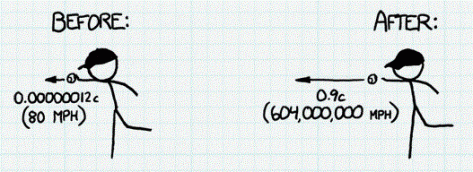When physics classes learn about relativity, typical problems involve calculating relative velocities, masses, or distances for objects moving near the speed of light, 3 * 10^8 m/s. These objects might be objects like spaceships, travelling in outer space, but they are often more common objects like cars and trains, or even baseballs. The two different locations (space and Earth) have radically different conditions. There are a lot more things to run into here on Earth. This begs the question: what would happen if an object were capable of moving near the speed of light in the atmosphere? Randall Munroe, the brilliant creator of the webcomic xkcd, answers this specific question on his what-if? page: “What would happen if you tried to hit a baseball pitched at 90% the speed of light?” The answer is not as pretty as one might believe.
Mr. Munroe does an excellent job of explaining exactly what happens (you should check it out), but I will summarize it here. The baseball actually fuses with the air molecules in front of it, releasing gamma rays. The gamma rays scatter and form an ever-expanding sphere of plasma, which moves at nearly the speed of light. It only takes 70 nanoseconds for the ball to reach home plate. When it does, the batter has no idea because the light that has just reached his eyes told him the pitcher only just let go of the ball. The bubble of superhot plasma makes short work of the bat, batter, and catcher, and proceeds to destroy the stadium and everything within a mile radius.
This “relativistic baseball” shows us just how fast light is. Nothing man-made exists that can possible compete with the speed of light. Light can cover the distance from the Earth to the Sun, an incredible 93 million miles, in only eight minutes. Once we have an appreciation for how fast light travels, we can begin to appreciate the true size of space. The nearest star to us, Proxima Centauri (along with its stellar neighbors, Alpha Centauri A and Alpha Centauri B), is located over 4.2 light years away. Light, travelling at an unmatchable speed, takes 4 years and 2½ months to get to Earth. If we will ever be able to reach another star, we’re going to have to come up with some non-traditional methods of travel that do not just involve moving yourself from point A to point B.

